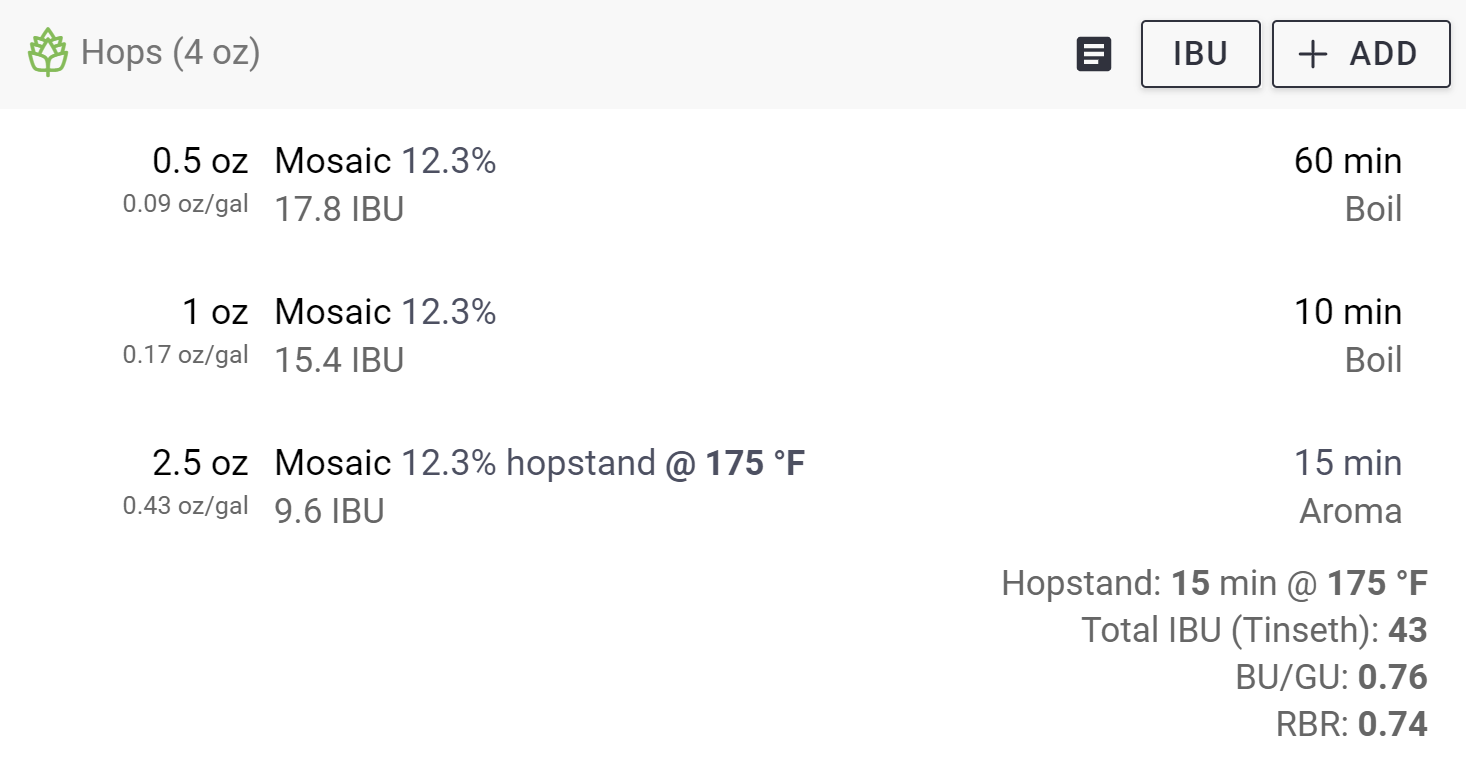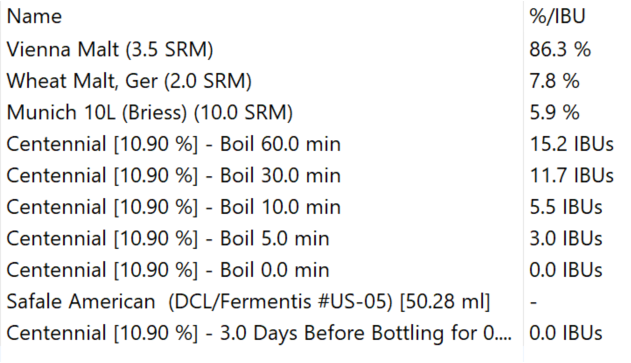Your SMASH sounds tasty. What yeast did you use?
It was 6% ABV and fermented with Chico WLP-001, Wyeast 1056 or Omega West Coast 1.

Your SMASH sounds tasty. What yeast did you use?
That Vienna-Mosaic SMASH Pale ale sounds yummy, Bobby M. What was your mash temperature and hops addition profile? I haven't had a good Vienna since I was last in Austria.There are many other ways of bringing malt complexity to a pale ale that does not involve crystal malts including Vienna, Munich, Victory/Biscuit and blending American and British pale malts. You can control the body via mash temp to make your own dextrines. I'm partial to a good portion of Vienna because it adds a candy like character without being overly sweet and that plays quite well with hops. I've actually done a SMASH pale ale with 100% Vienna and Mosaic hops and that was one of my best pale ales.
152FThat Vienna-Mosaic SMASH Pale ale sounds yummy, Bobby M. What was your mash temperature and hops addition profile? I haven't had a good Vienna since I was last in Austria.

Well very true. I was typically speaking of American. A rich Munich or straight maris otter would be excellent choices.There are many other ways of bringing malt complexity to a pale ale that does not involve crystal malts including Vienna, Munich, Victory/Biscuit and blending American and British pale malts. You can control the body via mash temp to make your own dextrines. I'm partial to a good portion of Vienna because it adds a candy like character without being overly sweet and that plays quite well with hops. I've actually done a SMASH pale ale with 100% Vienna and Mosaic hops and that was one of my best pale ales.
Well very true. I was typically speaking of American. A rich Munich or straight maris otter would be excellent choices.










Very true. I kinda posted a rant about the invasive light grain hopped "pale ales". Give me a summit epa any day for a standard. Of course the original post about crystal malt is ludicrous in high hopped ales.I actually mean that there is more flexibility in malt selection in beer styles than many people suspect. American Pale Ale is primarily driven by laying American (not noble) hop bitterness, flavor and aromas on top of a neutral malt base fermented with some kind of ale yeast. There are of course limits to how far you can stray but malt is probably the most flexible in that particular style. Bottom line, you can make an APA that passes as "in style" to an experienced judge with or without caramel malts. I'm not talking about some session version of a NEIPA that some craft breweries are calling pale ale either.
Vinnie from Russian River discussing (at 8 minutes)
I also heard mention of it in an interview with Vinny Cilurzo from Russian River. I started a thread about it in the Brew Science forum recently; if you’re interested in the Cilurzo interview, there‘s a link to it in the linked thread below. I think I saw the same Craft Beer and Brewing article you referenced, as well. Not a lot of details to be found, it seems.
https://www.homebrewtalk.com/threads/crystal-malt-and-oxidation.699464/
My question is then, how is it that Sierra Nevada’s beers like Pale and Torpedo still taste so damn good even at 3+ months old?
may suggest that crystal/caramel malts are appropriate for many styles of beer.Cilurzo’s preferred approach to a brown ale layers in malt flavors from a blend of crystal and chocolate, to push from sweet caramel to slightly bitter toffee and finally to a dry chocolate with a firm bitterness. He combines midrange crystal malts (such as 40L) and chocolate malt to get that effect. If you’re worried about the complexity you’d get from just the two malts, you could always combine several crystal malts to boost complexity. Cilurzo makes a point to differentiate between crystal (drum roasted) and caramel (kilned at higher temperature) because he senses higher roast notes in the crystal, which he prefers for a brown ale.
Was there anything in the video that offered a possible answer to the original question?
Thanks. I listened from about 1:04 to 1:09. Certainly something to consider.There's a question asked at the 1:04 mark, which I've linked below. The question was in the context of brewing light/helles lagers, but I'm thinking the answer still applies regardless.
It’s very interesting how he differentiates between the drum roasting of Crystal (U.S. I assume), and the kilning of Caramel (U.K. I assume). In the video interview posted earlier, he seems to specifically say that it’s the drum roasting of Crystal malts that he believes contributes to the oxidative quality. This makes me wondering if there would be a difference just between using US Crystal vs. UK Caramel malts in terms of the oxidative impact potential.This, from an article at Craft Beer and Brewing ("Paint the Town Brown - link" - Jun 26, 2021) on brown ales (including Janet's Brown Ale),
may suggest that crystal/caramel malts are appropriate for many styles of beer.
This article doesn't directly answer OPs question, but (as I mentioned earlier) if oxidation is a factor, there may be some mitigation techniques in The New IPA (or in other resources). Or hop processing and packaging (or lack there of) may be a factor. Or roasting vs kilning may be a factor. Packaging is certainly a consideration.
Oops, I think I got those backward.It’s very interesting how he differentiates between the drum roasting of Crystal (U.S. I assume), and the kilning of Caramel (U.K. I assume). In the video interview posted earlier, he seems to specifically say that it’s the drum roasting of Crystal malts that he believes contributes to the oxidative quality. This makes me wondering if there would be a difference just between using US Crystal vs. UK Caramel malts in terms of the oxidative impact potential.
There are many other ways of bringing malt complexity to a pale ale that does not involve crystal malts including Vienna, Munich, Victory/Biscuit and blending American and British pale malts. You can control the body via mash temp to make your own dextrines. I'm partial to a good portion of Vienna because it adds a candy like character without being overly sweet and that plays quite well with hops. I've actually done a SMASH pale ale with 100% Vienna and Mosaic hops and that was one of my best pale ales.

I don’t know how they seem to defy everything people say nowadays about C60 with hops.